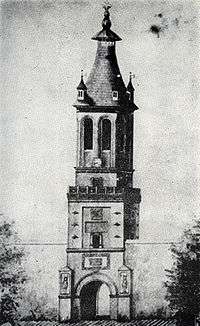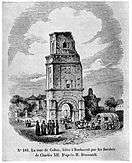1802 Vrancea earthquake
 | |
| Date | 26 October 1802 |
|---|---|
| Origin time | 12:55 (local time)[1] |
| Duration | 2 minutes and 30 seconds[2] |
| Magnitude | 7.9 Mw |
| Depth | 150 km (93 mi) |
| Areas affected | |
| Total damage | Hundreds of buildings destroyed |
| Max. intensity | IX–X[3] |
| Landslides | Yes |
| Aftershocks | 6 |
| Casualties | 4 |
The 1802 Vrancea earthquake occurred in the Vrancea Mountains of Romania on 26 October [O.S. 14 October] 1802, on St. Paraskeva's Day.[4][5] With an estimated intensity of 7.9 on the moment magnitude scale, it is the strongest earthquake ever recorded in Romania[5] and one of the strongest in European history. It was felt across an area of more than two million square kilometers in Eastern Europe and the Balkans, from Saint Petersburg to the Aegean Sea.[6]
In Bucharest, the earthquake had an estimated intensity of VIII–IX on the Mercalli scale.[7] It toppled church steeples[8] and caused Cotroceni Monastery to collapse. Numerous fires broke out, mainly from overturned stoves. In Bulgaria, the cities of Ruse, Varna and Vidin were almost completely destroyed.[9] The force of the earthquake cracked walls as far north as Moscow.
The main quake was followed by a series of aftershocks, of which the largest had a magnitude of 5.5.[10]
Damage and casualties


The main shock hit Bucharest between noon and 1 p.m.[11] The earthquake was felt for about 10 minutes and was so violent that all chimneys in the city collapsed.[6] Numerous historical monuments were destroyed, including St. Nicholas Church, Cotroceni Monastery and the 54-meter-high Colțea Tower.[12][13] The Greek chronicler Dionysius Fotino reported that Prince Constantine Ypsilantis moved with his family to the Văcărești Monastery because his palace was severely damaged.[4] However, despite the massive damage to buildings, only four deaths were reported: a Jewish woman and her baby, an itinerant merchant killed when Colțea Tower collapsed, and one other victim.[14] The death toll may have been so low because the houses were built far apart and surrounded by large yards and gardens, so the buildings' vibrations did not propagate. Also, the building materials—mostly shingle and timber—were light.[15]
In Iași, the walls of princely courts fell, and many churches and monastery towers collapsed. In Suceava, the Armenian Church steeple cracked, while in Pașcani, cracks appeared in the walls of St. Archangels Church. Other religious buildings damaged during the earthquake include the Princely Church of the Assumption in Bârlad and Cașin Monastery in Bacău.
Brașov and its surroundings, including the city's Black Church, were severely affected.[16] According to local chronicles, in the village of Bod, more than 50 houses and several churches were damaged or destroyed. In Feldioara, a column of water rose several meters into the air from a crack caused by the earthquake.[17] Buildings collapsed in Sibiu, including the city's Catholic church.[18]
Constantine Ypsilantis entering the church of Radovan (on his way to Bucharest)
Constantinople and neighboring provinces also suffered extensive damage. Initially, it was thought that Constantinople, the capital of the Ottoman Empire, had been completely destroyed.[19] A letter from Petrovaradin described particular devastation in the Galata district, Topkapı Palace, the Hagia Sophia and the Edirne bazaar.[20] The main shock and subsequent aftershocks lasted up to 30 minutes.[21]
At 1:30 p.m., violent tremors were felt in what is now Ukraine. The aftershocks, six in total, lasted three minutes and were so strong that masonry buildings in Kiev and Lviv were shaken and the city bells began to ring.[22][23] The Gentleman's Magazine reported damage in Moscow: "the walls were cracked, the windows were shattered and vaults fell".[24] Anatolie Drumea, an academic from Chișinău, wrote in a letter that a nanny was walking a little boy in a stroller in the courtyard of the Lomonosov University library when, at 1:53 p.m., "the statues began to fall" and the stone benches were overturned. The boy was the future Russian poet Alexander Pushkin.[25]
Intensity
| Location | Intensity |
|---|---|
| | IX |
| | VIII–IX |
| | VIII |
| | VII |
| | VI |
| | V–VI |
| | IV–V |
Restoration of Bucharest
After the earthquake, Constantine Ypsilantis ordered the immediate restoration of Bucharest. To prevent masons and craftsmen from profiting from the disaster, he set maximum wages for their work. Bucharest was rebuilt within a few years, although some buildings and structures were never restored to their pre-earthquake state.[4]
Several earthquakes occurred in subsequent years, but they caused comparatively little damage. One, on 15 June 1803, affected Bucharest's water system and rendered many pumps unusable. Three other major earthquakes occurred in 1804 and 1812.[26]
See also
- 1986 Vrancea earthquake
- 1977 Vrancea earthquake
- 1940 Vrancea earthquake
- List of earthquakes in Vrancea County
References
- ↑ Constantin, A. P.; Pantea, A.; Stoica, R. (25 May 2010). Vrancea (Romania) subcrustal earthquakes: historical sources and macroseismic intensity assessment (PDF). Bucharest: National Institute for Earth Physics.
- ↑ "Cel mai puternic cutremur înregistrat vreodată pe teritoriul României". Atlas Geografic (in Romanian). 21 May 2015.
- ↑ "Cutremurul vrâncean major din 26 octombrie 1802". Cutremur.net (in Romanian).
- 1 2 3 Marius Ionescu. "Bucureștiul și Marele Cutremur de la 1802". Historia.ro (in Romanian).
- 1 2 Georgescu, Emil-Sever (August 2004). "Forensic Engineering Studies on Historical Earthquakes in Romania" (pdf). 13th World Conference on Earthquake Engineering. Vancouver, B.C. Retrieved 17 March 2015.
- 1 2 Frohlich, Cliff (7 January 2010). Deep Earthquakes. Cambridge: Cambridge University Press. p. 17. ISBN 978-0521123969.
- ↑ Georgescu, E. S. (24–26 October 2002). The partial collapse of Coltzea Tower during the Vrancea earthquake of 14/26 October 1802: the historical warning of long-period ground motions site effects in Bucharest (PDF). Bucharest: The International Conference Earthquake Loss Estimation and Risk Reduction.
- ↑ Kozák, Jan; Čermák, Vladimír (2010). The Illustrated History of Natural Disasters. Dordrecht: Springer. ISBN 9789048133246.
- ↑ Popescu, I. G. (May–June 1941). Etude comparative sur quelques tremblements de terre de Roumanie, du type du celui du 10 novembre 1940 (in French). Bucharest: Cartea Romaneasca.
- ↑ Constantin, Angela Petruța; Moldovan, Iren-Adelina; Toader, Victorin Emilian (25–29 August 2014). "Depth and magnitude estimation of the two strongest earthquakes occurred on the Romanian territory in 19th century" (PDF). Second European Conference on Earthquake Engineering and Seismology. Istanbul.
- ↑ Giurescu, Constantin C. (1966). Istoria Bucureştilor din cele mai vechi timpuri până astăzi. Bucharest.
- ↑ Zaicenco, Anton; Craifaleanu, Iolanda; Paskaleva, Ivanka (20 May 2008). Harmonization of Seismic Hazard in Vrancea Zone: with Special Emphasis on Seismic Risk Reduction. Chișinău: Springer. pp. 101–102. ISBN 978-1-4020-9242-8.
- ↑ Georgescu, Emil-Sever (1999). Coltzea Tower, earthquakes and Bucharest. INCERC.
- ↑ The European Magazine: And London Review, volume 42.
- ↑ "The earthquake of 1802". Radio România Internațional. 11 May 2009.
- ↑ Nussbächer, G. (1987). Din cronica cutremurelor în Ţara Bârsei (secolele XV-XX) (in Romanian). Kriterion. pp. 54–58, 231–233.
- ↑ Quin, Michael Joseph (1836). A steam voyage down the Danube. With sketches of Hungary, Wallachia, Servia, Turkey, &c. London: R. Bentley.
- ↑ Réthly, A. (1952). A Kárpátmedencék földrengései (455–1918) (in Hungarian). Budapest.
- ↑ Nouveau dictionnaire d'histoire naturelle, appliquée aux arts, à l'agriculture, à l'économie rurale et domestique, à la médecine, etc [New dictionary of natural history, applied arts, agriculture, rural and home economics, medicine, etc.] (in French). Paris: Chez Deterville. 1816.
- ↑ "The European Magazine, and London Review".
- ↑ Mihaela Dicu (21 January 2014). "Cutremurele din România (partea I)". Astrele (in Romanian).
- ↑ Nova acta Academiae scientiarum imperialis petropolitanae (in Latin). Petropolis: Typis Academiae Scientiarum. 1783.
- ↑ Nichols, Jack. The Gentleman's Magazine, volume 92. p. 1151.
- ↑ Nichols, John. "Abstract of Foreign Occurrences". The Gentleman's Magazine.
- ↑ Borcea, Ştefan (26 April 2014). "Poetul rus Aleksandr Puşkin, martor al devastatorului cutremur care a avut loc în 1802, în Vrancea". Adevărul. Archived from the original on 8 January 2015. Retrieved 2015-01-05.
- ↑ Ramona Ursu (4 March 2012). "Blestemele lui Dumnezeu asupra Capitalei: istoria cutremurelor care i-au îngrozit pe bucureșteni. Cum s-a refăcut orașul!". Adevărul (in Romanian).
Coordinates: 45°43′N 26°43′E / 45.72°N 26.72°E